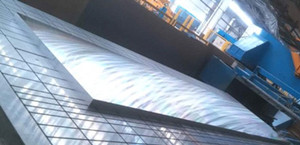
Case
"Edge Passivation Strengthening" applied in the high-speed surface milling for aluminum alloy

1. Processing parameters:
|
Work-piece |
Aluminum alloy plate (3600×1570mm), |
|
Linear speed |
3200m/min(diameter of cutter head Φ2820mm |
|
Speed: |
320~400 RPM |
|
Cutting depth |
0.05 mm |
2. Tools:
PCD polishing tools, size R275, rear Angle 15°, material CMX850

Passivation was performed on the tool tip with a value of 0.01mm

Passivation scheme
1. Analysis:
PCD Tool in the debugging stage, the initial wear stage has a certain probability of collapse edge, train of thought for simulation tool wear condition, the PCD Tools slice passivation, let tool directly into normal wear stage at the expense of a certain life in exchange for stability.

By studying the micro morphology of imported cutting tools, analyzing the cutting edge wear of our tools after using 50-100㎡, and then according to the existing passivation means, the passivation plan is developed.

2. Passivation scheme:
Passivation belt is formed on the front cutter face, the Angle is -1~-2° with the front cutter face, and the width is < 100μm;
Passivation band ② is formed on the rear cutting surface, the Angle is -1~-2° with the rear cutting surface, and the width is < 200μm.
The boundary edge of the passivation band ①② forms a blunt circle with R < 10μ.

Passivation area between the front cutter face and the tip

Passivation area ② and R0.005mm for the rear surface and tip
Result
PCD tools in the initial use of non - collapse edge finish Ra2.8, the average life of 85㎡
Conclusion
Under the condition that the edge Angle is allowed, the edge band strengthening can improve the edge strength, reduce the edge breaking rate, although approximately 5% of tool life is sacrificed but the improved stability results in user acceptance;
In the occasion of high speed milling, the cutting edge passivation strengthening method can also improve the cutting edge strength, reduce the breaking rate and improve the comprehensive performance of PCD tool, but it is necessary to pay attention to the selection of appropriate passivation method and parameters.
It can be seen that PCD tool because of its excellent wear resistance and high hardness, the edge wear is slow, under ideal conditions can realize the processing of long life.
However, due to its brittleness, it will lead to a certain blade breaking rate in the early use of the tool, which will affect the stability of the whole life.
Through the above tests, it can be seen that the use, wear and failure forms of PCD tools with higher requirements are carefully studied. Through comparative analysis, targeted reinforcement treatment of the cutting edge is an important means to improve its stability.
Comparison of ns, ps, and fs lasers for PCD, carbide, and ceramic machining, and how Moresuperhard’s 5-axis laser PCD grinding machine delivers high-precision cold laser processing.
Learn how to choose the right PDC cutters for deep and hard rock formations. Explore diamond thickness, thermal stability, impact toughness, cutter geometry, and bit design.
Add: Zhongyuan Rd, Zhongyuan District, Zhengzhou, 450001, Henan, China
Tel: +86 17700605088